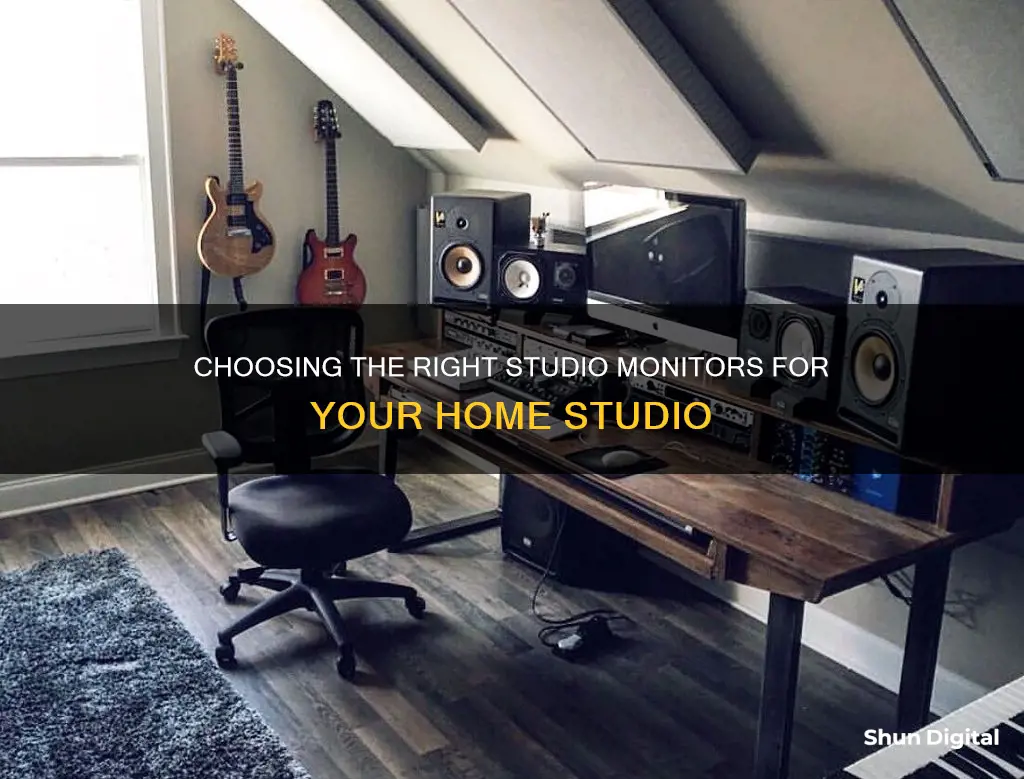
Studio monitor placement is a crucial aspect of achieving optimal sound quality in a recording or listening environment. The position of studio monitors can significantly impact the overall sound experience, influencing the way sound waves travel and interact with the surroundings. The goal is to create a natural balance of sounds, minimizing the impact of room acoustics and reducing peaks and valleys in the frequency response. One of the key considerations is forming an equilateral triangle with the monitors, ensuring they are pointed directly towards the listener's head. This setup helps maintain a consistent listening perspective and minimizes high-frequency directionality issues. Additionally, factors such as room dimensions, symmetry, monitor height, and distance from walls play a vital role in achieving the desired sound quality.
What You'll Learn

Studio monitors should be placed along the short wall of a room
In a small room, the short wall gives you more wiggle room. It's important to place your setup in the centre of the wall to keep the symmetry of soundwaves, which improves sound quality and balance.
If you have a large room, the equilateral triangle setup is still important. The listening position should be no more than a third of the room's average length and width dimension. This ensures that the listener is in the 'nearfield' region, where the sound heard is predominantly direct from the monitors, rather than the 'reverberant field', where sound has bounced off the walls.
The ideal setup for stereo listening/mixing is an equilateral triangle, with the listening position at the apex. This gives the best frequency representation and stereo imaging.
The height of the monitors is also important. They should be at ear height, with the perpendicular axis pointing towards the listener's head.
Monitoring Linux Memory Usage: Tracking a Process
You may want to see also

The tweeters of studio monitors should be at head height
When setting up studio monitors, the aim is to achieve a balanced, non-distorted sound experience. The location of the monitors will impact how you hear your music, and the tweeters' position is an important factor in this.
High-frequency sound tends to be more directional than bass, so it's crucial to ensure that your high-frequency speakers are aligned or pointed directly towards your ears. The tweeters of studio monitors should ideally be at ear height or head height, as this focuses the sound on the listener and ensures they don't miss any details in the music.
If the tweeters are placed too low, sound muffling can occur. Sound techs suggest a minimum height of 47 inches from the floor to avoid this issue. However, some people prefer having their studio monitors slightly above their heads, which is also acceptable as long as the monitors are pointed downward towards the listener.
The height of the tweeters can also depend on the type of monitors being used. For example, ITU Standard Monitors are typically positioned anywhere from 47 to 55 inches from the ground, right at ear level.
Additionally, the distance between the listener and the monitors is crucial. Near-field monitors, for instance, are designed for use at close ranges, usually within two feet of the listener. On the other hand, mid-field monitoring doesn't require tweeters to be at ear level as the sweet spot is inherently wider.
In conclusion, while there may be some flexibility in the height of studio monitor tweeters, ensuring they are at or around head height is crucial for optimal sound quality and directionality.
Asus Monitor Release Schedule: When to Expect New Models
You may want to see also

Studio monitors should be angled towards the listener's ears
The high-frequency sound tends to be more directional, so if the studio monitors are not aimed at the listener's ears, some of the high-frequency content will be lost. By pointing the studio monitors directly at the listener's ears, you ensure that you are hearing the most direct sound, which is crucial for accurate mixing and mastering.
Additionally, the distance between the studio monitors and the listener is important. "Near-field" monitoring refers to monitoring where the listener is hearing more of the speaker and less of the room's reflections. In small rooms, this typically means the listening position is three to five feet from the monitors.
To find the ideal listening position, it is recommended to experiment with different positions in the room and play test tracks to compare the sound quality. The ideal listening position will be one where you are hearing everything in your mix correctly, with a balanced stereo image.
Mounting Non-VESA LCD Monitors: A Simple Guide
You may want to see also

Studio monitors should be placed on stands, not desktops
Acoustic Isolation
The stands should be made of a soft rubber material to dampen vibrations coming from the speaker and keep them from transmitting to the surface the monitor is placed on. The speakers should radiate all acoustic energy towards the listener. If acoustic isolation is not achieved with rubber feet, some energy is lost as it transmits to the desk or surface, colouring the sound of your studio monitors.
Height Positioning
Raising the height of the monitors is crucial so that they radiate directly at ear level. This ensures you hear the sound of your monitors as intended. High-frequency waves are more directional, so they should be at ear level, especially in the near field.
Strength
Monitor stands should be strong enough to reliably support your monitor speakers. They should be small enough to fit your space but strong enough to handle the weight without issues.
Size and Flexibility
Your stands should be able to work with varying speaker sizes and be easy to manoeuvre on a desk. It should be effortless to angle the speakers towards the listener for the most effective sound response.
Avoid Desktop Placement
Placing your monitors directly on the desk can smear and muffle your audio. Sound waves travel fast through wood and other materials, so you may feel the sound from these materials before you hear the sound in the air.
Cloning Monitors: Performance Impact and Optimization Strategies
You may want to see also

Bass traps should be placed behind studio monitors
Bass traps are essential for absorbing low-frequency pressure and reducing the amount of bass energy that reflects in a room. They are a vital form of acoustic treatment, particularly in small rooms, where low frequencies can quickly become problematic. Bass traps should be placed in areas where maximum pressure builds up, such as walls, floors, and ceilings, especially in corners where walls and the floor or ceiling meet.
The placement of bass traps is crucial to optimising their effectiveness. Here are some guidelines for their placement:
- Floor-to-Ceiling Bass Traps: Placing bass traps from floor to ceiling in the front left and right corners of a room is an effective strategy. This approach not only covers critical trihedral corners but also spans four dihedral corners, maximising the impact of the treatment.
- Behind the Monitors: Bass traps can be placed behind studio monitors to reduce reflections and improve overall sound quality. This is particularly beneficial in small rooms where monitors are typically positioned close to boundaries, which can cause frequency response issues.
- Wall-Ceiling Tri-Corners: In addition to the front corners, bass traps can be placed in the wall-ceiling tri-corners, addressing all critical trihedral corners in a rectangular room.
- Ceiling Bass Traps: Bass traps can be hung a few inches from the ceiling, forming a "cloud" that does not take up valuable floor or wall space. This approach is advantageous in rooms with low ceilings, often the smallest dimension, which can result in problematic bass build-up.
- Sidewall Bass Traps: Bass traps can also be placed on the sidewalls, either as part of a Reflection Free Zone treatment or to target specific upper bass frequencies and reduce mid-range and high-frequency reflections.
When placing bass traps, it is essential to ensure symmetry and maintain an equal distance from the sidewalls to the respective monitors. Additionally, it is recommended to use a combination of bass traps and velocity or porous panels to "sculpt" the acoustics of the room precisely, avoiding over-absorption of mid and high frequencies.
Overall, the placement of bass traps is a critical aspect of studio monitor setup, and their proper positioning can significantly enhance the accuracy and quality of sound reproduction.
Setting Up Elgato: A Guide to Monitor Connection
You may want to see also
Frequently asked questions
The ideal setup for stereo listening or mixing is to have an equilateral triangle with your listening position being at the apex, with the monitors turned inwards so that their front panels face you.
The first thing to consider when figuring out studio monitor positioning is to know where you will be sitting. Your position is going to determine where the monitors go and will depend on a variety of factors as well as personal preference.
If you have serious sound monitors, you should keep your distance to avoid hearing damage. Strong monitors should either be toned down or distanced from the listener. Most people will want to maintain a minimum of 3 feet away from a large, professional-grade system.
In most home studios, keeping your monitors at your ear's height is a safe bet. This focuses the sound on you and makes sure you don't get extra noise.
In small spaces, a pair of monitors might be as little as 1 metre apart. Such an arrangement is perfectly viable if the equilateral triangle principle is implemented.







